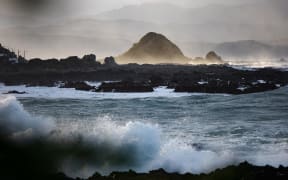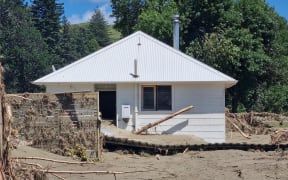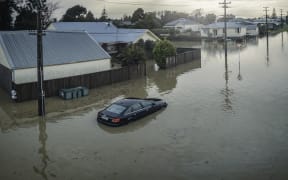
Photo: RNZ / MARIKA KHABAZI
The next three months should see normal rainfall across almost the whole the country and with El Niño now in effect, a lower likelihood of tropical moisture plumes.
It comes after soggy first half of the year including a May that saw rainfall at 149 percent of normal for many regions across the nation.
The National Institute of Water and Atmospheric Research (NIWA) says the country is now experiencing El Niño and it is expected to deliver an average amount of rainfall for the eastern regions of the North Island over winter.
Climate scientists have been expecting the country would move away from La Niña's warm and wet weather to El Niño with chillier southwesterly winds but a more normal rainfall pattern.
NIWA has now released its seasonal climate outlook for the next three months.
"The developing El Niño is expected to result in a lower likelihood of tropical moisture plumes, such as those that frequently affected the country during the first half of this year," the report said.
The report forecast that along the North Island's east coast - which has been saturated in many parts in the last few months - there will be a near normal amount of rain.
Those in the South Island's west can expect near or above normal rainfall while it will be the average amount or possibly less for the rest of the country.
Temperatures are also likely to be in the near average or above average range for the entire country.
However, short sharp cold spells, such as the chilly snap forecast for the start of July, will also feature.
"Coastal sea surface temperatures ranged from 0.4degC to 1.8degC above average during June. The warmer than average seas may reduce the intensity of cold, southerly air masses."
There may be more souwester winds over the next three months all over the country, while seasonal wind strength may be above normal in spring, Niwa said.
Soil moisture levels are most likely to be near normal in all regions.
Climate outlook for Jul-Sep 2023! ️
— NIWA Weather (@NiwaWeather) June 29, 2023
️ Several regions may be drier-than-normal as El Niño builds in the months ahead
More frequent southwesterly winds will bring occasional cold snaps, but it's unlikely to be a colder-than-average period for mosthttps://t.co/hZFTyLabLu pic.twitter.com/b7b8YF51kW
Regional predictions
Northland, Auckland, Waikato and Bay of Plenty
- Temperatures are about equally likely to be above average (50 percent chance) or near average
- Rainfall totals are about equally likely to be below normal (45 percent chance) or near normal (40 percent
- Soil moisture levels are most likely to be near normal (40 percent chance) while river flows are
(45 percent chance).
chance). Higher than normal air pressure may build across the Tasman Sea at times, leading to spells of drier than normal weather.
about equally likely to be below normal (45 percent chance) or near normal (40 percent chance).
Central North Island, Taranaki, Whanganui, Manawatū, Wellington
- Temperatures are about equally likely to be above average (50 percent chance) or near average
- Rainfall totals are about equally likely to be below normal (40 percent chance) or near normal (35 percent chance). Higher than normal air pressure may build across the Tasman Sea, leading to spells of drier than normal weather.
- Winds may be stronger than normal, especially around the start of spring.
- Soil moisture levels are most likely to be near normal (45 percent chance) while river flows are
(45 percent chance). Marine heatwave conditions remain present in coastal waters. The warmer
than average seas may reduce the intensity of cold, southerly air masses.
about equally likely to be below normal (40 percent chance) or near normal (35 percent chance).
Gisborne, Hawke's Bay, Wairarapa
- Temperatures are about equally likely to be above average (50 percent chance) or near average
- Rainfall totals are most likely to be near normal (45 percent chance).
- The developing El Niño is expected to result in a lower likelihood of tropical moisture plumes; however, the atmosphere may still exhibit La Niña-like tendencies at times, increasing the chance for heavy rain.
- Winds may be stronger than normal, especially around the start of spring.
- Soil moisture levels and river flows are most likely to be near normal (45 percent chance).
(45 percent chance).
Tasman, Nelson, Marlborough, Buller
- Temperatures are about equally likely to be above average (50 percent chance) or near average
- Rainfall totals are about equally likely to be below normal (40 percent chance) or near normal (35 percent chance). More frequent and stronger-than-normal southwesterly quarter winds may shelter
- Soil moisture levels are most likely to be near normal (45 percent chance) while river flows are
(45 percent chance). Marine heatwave conditions remain present in coastal waters. The warmer
than average seas may reduce the intensity of cold, southerly air masses.
the region, leading to dry spells.
about equally likely to be below normal (40 percent chance) or near normal (35 percent chance).
West Coast, Southern Alps and foothills, inland Otago, Southland
- Temperatures are about equally likely to be above average (50 percent chance) or near average (45 percent chance). Marine heatwave conditions remain present in coastal waters. The warmer than
- Rainfall totals are about equally likely to be near normal (40 percent chance) or above normal (35 percent chance). Southwest quarter winds are expected to increase in frequency and strength over the
- Soil moisture levels are most likely to be near normal (45 percent chance) while river flows are about
average seas may reduce the intensity of cold, southerly air masses, especially near the coast.
period, likely bringing periods of wetter than normal conditions.
equally likely to be near normal (40 percent chance) or above normal (35 percent chance).
Coastal Canterbury and the nearby plains, east Otago
- Temperatures are about equally likely to be above average (50 percent chance) or near average
- Rainfall totals are about equally likely to be below normal (40 percent chance) or near normal (35 percent chance). More frequent and stronger-than-normal southwesterly quarter winds may shelter
- Soil moisture levels are most likely to be near normal (45 percent chance) while river flows are
(45 percent chance). Marine heatwave conditions remain present in coastal waters. The warmer
than average seas may reduce the intensity of cold, southerly air masses, especially near the
coast.
the region, leading to dry spells.
about equally likely to be below normal (40 percent chance) or near normal (35 percent chance).







